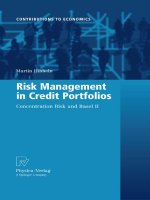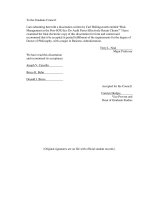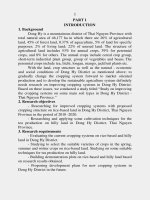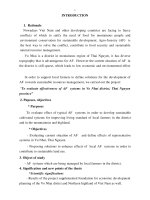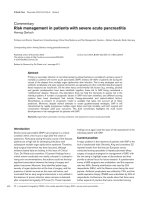credit risk management in agribank thai nguyen province
Bạn đang xem bản rút gọn của tài liệu. Xem và tải ngay bản đầy đủ của tài liệu tại đây (509.14 KB, 127 trang )
Thai Nguyen University
Socialist Republic of Vietnam
Southern Luzon State University
Republic of Philippines
CREDIT RISK MANAGEMENT IN AGRIBANK – THAI NGUYEN PROVINCE
A Dissertation
Presented to the
Faculty of Graduate School of
Southern Luzon State University, Philippines and
Thai Nguyen University, S.R. Vietnam
In Partial Fulfillment
of the Requirements for the Degree
Doctor in Business Administration
BUI VAN KHOA (BILLY)
August 2013
ii
APPROVAL SHEET
iii
DEDICATION
This piece of work is dedicated
To my wife and my children,
All the staffs of the
Agribank in Thai Nguyen Province
iv
ACKNOWLEDGMENT
The researcher wishes to extend him most since gratitude to the following
people who made this piece of work a reality.
Dr. Cecilia N. Gascon, President of Southern Luzon State University, Republic
of the Philippines, who made possible the linkage with Thai Nguyen University and
the offering of Doctor of Business Administration, through the ITC-TUAF;
Dr. Dang Kim Vui, the President of Thai Nguyen University, who made the
linkage with Southern Luzon State University, Republic of the Philippines and the
offering of Doctor of Business Administration, through the ITC-TUAF;
Dr. Walberto A. Macaraan, for his support and supervision throughout my
graduate study program. His kindness and daily instructions in the last three years are
greatly appreciated and this dissertation is as much his work as mine;
Prof. Nordelina Ilano, Director, Office for International Affairs of URS for her
support to the DBA1 students;
Dr. Tran Thanh Van, the Dean of the Graduate School of Thai Nguyen
University, for his assistance and encouragement to pursue this study;
Dr. Dang Xuan Binh, the Director of International Training Center, for his
assistance and encouragement to pursue this study;
Dr. Nguyen Thanh Hai, the Vice Director of International Training Center, for
his assistance and encouragement to pursue this study as DBA Class Manager;
To all the SLSU and TNU Professors, for their support and guidance extended
throughout the graduate studies in Thai Nguyen University, Vietnam;
To his ever dearest friends for their kindness and remarkable support;
To his family, for their support, encouragement for being the sources of
greatest inspiration, which made his career a success.
v
ABSTRACT
This study was conducted on the basis of practical reasoning combined with
analysis of the status and operation characteristics of the Bank for Agriculture and
Rural Development, Vietnam to build a strategy for credit risk management
effectiveness, which proposed solutions and recommendations for improvement,
improve credit risk management of the Bank for Agriculture and rural Development
of Vietnam, contributing to the economic restructuring of agriculture and rural
towards industrialization and modernization, promoting our country's economic
integration and development.
The result will the present situation of credit risk in terms of bad debts, undue
debts, overdue debts, debts requiring attention, under qualified debts, doubtful debts
and frozen debts. as perceived by managers and staff of the Agribank, and from that,
the researcher recommended the appropriate solutions to limit credit risk in effective
ways in bank.
The findings of the study shows that with respect to “segment structure which
contain the big risks”, respondents evaluated it with mean of 3.5 corresponding to
level More Risky. The evaluated the item “Credits for industries” with highest mean
of 3.6 corresponding to level More Risky and ranking first of all. They evaluated the
item “Credits for service sector” with lowest mean of 3.2 corresponding to level Risky
and ranking last of all. For overall assessment of both managers and staffs, they
evaluated all items of ‘types of customers, which contain the big risks” with mean of
3.4 corresponding to level More Risky. They evaluated the item “individuals” with
mean of 3.6 corresponding to level More Risky and ranking first of all. They
evaluated the item “Big companies and organizations “ with lowest mean
vi
corresponding to level Risky and ranking last of all. For overall assessment of two
groups of respondents, they evaluated all items of “not have guarantee properties”
with mean of 3.1 corresponding to level Risky. They evaluated the item “Not have
guarantee properties” highest mean of 3.6 corresponding to level More Risky and
ranking first of all. While, the item “Have guarantee properties’’ was evaluated with
lower mean corresponding to level Less Risky. With respect to “the account
outstanding acc to time”, two groups of respondents evaluated short term credit with
highest mean of 3.5 corresponding to level More Risky and ranking first. While, the
item “medium and long term credit” received lower mean of 3.2 corresponding to
level Risky and ranking last. With respect to overdue debts, both groups of managers
and staffs evaluated all items of “overdue debt” with mean of 3.3 corresponding to
level Risky. They gave highest mean of 4.3 for the item “Both principal and interest
can be recovered partially” corresponding to level Most Risky and ranking first.
While, the item “Both principal and interest can be recovered fully” was evaluated
with lowest mean of 2.4 corresponding to level Less Risky and ranking last of all.
With respect to undue debt, both groups of respondents evaluated “undue debt” with
mean of 3.2 corresponding to level Risky. They evaluated the item “Customers are
traditional borrowers” with highest mean of 3.5 corresponding to level More Risky
and ranking first of all. They evaluated the item “It is easy to collect principle and
interest” with lowest mean of 3.1 corresponding to level Risky and ranking last of all.
With respect to “debt requiring attention”, two groups of respondents evaluated “debt
requiring attention” with mean of 3.6 corresponding to level More Risky. They
assessed the item “The interest rate is suitable for customers” with highest mean of
3.6 corresponding to level More Risky and ranking first. While, the item “The
mechanism for this debt is so clear” received lower mean of 3.5 corresponding to rank
vii
last. With respect to qualified debt two groups of respondents evaluated “qualified
debt” with mean of 2.9 corresponding to level Risky. They evaluated the item “Able
to pay the interest and principle at maturity” with highest mean of 3.6 corresponding
to level More Risky and ranking first of all. The item “The interest is made free for
customers” was evaluated with lowest mean of 1.7 corresponding to level Least Risky
and ranking last of all. With respect to doubtful debt, all respondents evaluated the
item “The bank controls closely this type of debt” with highest mean of 4.3
corresponding to level Most Risky and ranking first of all. While, they evaluated the
item “Creditors do not carefully appraise the borrowers” with lowest mean of 3.5
corresponding to level More Risky and ranking last of all. With respect to frozen debt,
two groups of respondents evaluated frozen debt with mean of 3.3 corresponding to
level Risky. They evaluated the item “There are a lot of customers classified in frozen
debt group” with highest mean of 3.6 corresponding to level More Risky and ranking
first of all; and evaluated the item “The rate of frozen debt is too high” with lowest
mean of 3.2 corresponding to level Risky and ranking last of all. With respect to “bad
debt”, both groups of respondents evaluated the item “It is difficult to collect both
interest and capital” with highest mean of 3.7 corresponding to level More Risky and
ranking first of all. While, the item “The mortgage is hard to sell” was evaluated with
lowest mean of 3.5 corresponding to level More Risky and ranking last. Considering
all items of “bad debt”, they evaluated them with mean of 3.6 corresponding to level
More Risky. With respect to items of subjective criteria, all respondents evaluated all
items of subjective criteria with mean of 3.6 corresponding to level Frequent. They
evaluated the item “Credit process follows the common regulations of State bank”
with highest mean of 4.3 corresponding to level Always and ranking first. While, the
item “The information quality in banking network and outside is good” was evaluated
viii
with lowest mean of 2.8 corresponding to level Often and ranking last. With respect to
objective criteria, both groups of respondents evaluated all items of objective criteria
with mean of 3.7 corresponding to level Frequent. They evaluated the item “The
political and legal environment is stable” with highest mean of 4.5 corresponding to
level Always and ranking first of all. While, the item “The economic environment
facilitates for both bank and customer” was evaluated with lowest mean of 3.1
corresponding to level Often and ranking last of all. With respect to the Credit
activities aspects of Agribank Thai Nguyen in term of four aspects, both groups of
respondents evaluated the Credit activities aspects of Agribank Thai Nguyen term of
four aspects with mean of 3.3 corresponding to level Risky. They evaluated the item
“Segment structure contain the big risks” with highest mean of 3.5 corresponding to
level More Risky and ranking first of all. They gave lowest mean for “Based on the
guarantee level, types of guarantee contain the big risks” with mean of 3.1
corresponding to level Risky. With respect to all items of Current status of debts, both
groups of respondents, they evaluated all items with mean of 3.4 corresponding to
level More Risky. They evaluated the item ‘doubtful debt” with mean of 4.0
corresponding to level Risky and ranking first of all. They evaluated the item “under
qualified debt” with lowest mean of 2.9 corresponding to level Risky and ranking last
of all. With respect to two aspects affecting the risk management of credit,
respondents evaluated them with mean of 3.7 corresponding to level More Risky.
Two items were evaluated with a same mean of 3.7.
It is recommended that the research and define the appropriate types of credit
for individuals. The bank should require guarantee properties for credits. The bank
should pay more attention more on long – term and medium credits. Review
procedure and conditions of them to manage and control in order to minimize risks of
ix
credit. Review to define appropriate solutions to collect interest and capital. Review
and find suitable solutions to recovery both principle and interest fully. Research to
find suitable solutions to collect principle and interest. Review to produce clear
mechanism for “debt requiring attention”. Review to decrease cost to improve the
competitive ability of services. Creditors should carefully appraise the borrowers.
Review to define exactly ability of borrowers before credits. Review to establish a
good information network. Carefully manage segment structure; define exactly
targeted customers. The bank should pay attention on both subjective criteria and
objective criteria affecting on risk management of credit.
x
TABLE OF CONTENTS
TITLE PAGE Page
APPROVAL SHEET ii
DEDICATION iii
ACKNOWLEDGMENT iv
ABSTRACT v
TABLE OF CONTENTS x
LIST OF TABLES xii
LIST OF FIGURES xiv
CHAPTER
1 INTRODUCTION………………………………………………………………1
Background of the Study 2
Statement of the Problem 3
Hypothesis of the Study 5
Significance of the Study 5
Scope and Delimitation 6
Definition of Terms 6
2 REVIEW OF LITERATURE AND RELATED STUDY ………………… …8
Review of Related Literature 8
Review of Related Studies 31
Conceptual Framework 55
3 METHODOLOGY……… ………56
Research Design 56
Population and Sampling 56
xi
Sampling Design and Techniques 57
Research Instruments 58
Data Gathering Procedures 59
Statistical Treatment 60
4 PRESENTATION ANALYSIS AND INTERPRETATION OF DATA… 61
5 SUMMARY OF FINDINGS, CONCLUSIONS AND RECOMMENDATIONS.91
Findings 91
Conclusions 96
Recommendations 97
BIBLIOGRAPHY 99
APPENDICES A 101
APPENDICES B 102
QUESTIONNAIRE 103
CURRICULUM VITAE 109
xii
LIST OF TABLES
Table
Page
1
Frequency and Percentage of respondent’s profile
61
2
Mean Distribution of Respondents on Credit risk management of
Agribank Thai Nguyen in terms of segment structure 62
3
Mean Distribution of Respondents on Credit risk management of
Agribank Thai Nguyen in types of customers 64
4
Mean Distribution of Respondents on Credit risk management of
Agribank Thai Nguyen in types of guarantee 65
5
Mean Distribution of Respondents on Credit risk management of
Agribank Thai Nguyen in terms of account outstanding 66
6
Mean Distribution of Respondents on Credit risk management of
Agribank Thai Nguyen in Overdue debt 68
7
Mean Distribution of Respondents on Credit risk management of
Agribank Thai Nguyen in Undue debt 69
8
Mean Distribution of Respondents on Credit risk management of
Agribank Thai Nguyen in Debt requiring attention 71
9
Mean Distribution of Respondents on Credit risk management of
Agribank Thai Nguyen in Under qualified debt 72
10
Mean Distribution of Respondents on Credit risk management of
Agribank Thai Nguyen in Doubful debt 73
11
Mean Distribution of Respondents on Credit risk management of
Agribank Thai Nguyen in Frozen debt 75
12
Mean Distribution of Respondents on Credit risk management of
Agribank Thai Nguyen in Bad debt 76
13
Mean Distribution of Respondents on Credit risk management of
Agribank Thai Nguyen in Subjective criteria 78
14
Mean Distribution of Respondents on Credit risk management of
Agribank Thai Nguyen in Objective criteria 79
15
Summary table on the Assessment of the Two groups of Respondents
the Credit activities aspects of Agribank Thai Nguyen term of four
aspects 81
16
Summary table on the Assessment of the Two groups of Respondents
82
xiii
the Current status of debts of Agribank Thai Nguyen term of Current
status of debts
17
Summary table on the Assessment of the Two groups of Respondents
the factors affecting the limitation of Credit Risks of Agribank Thai
Nguyen in term of two aspects 84
18
T-test Results for the Differences on the Assessment of Two Groups
of Respondents on the Agribank Thai Nguyen 87
19
T-test Results for the Differences on the Assessment of Two Groups
of Respondents on the Current status of debts Agribank Thai Nguyen 88
20
T-test Results for the Differences on the Assessment of Two Groups
of Respondents on the factors affecting the limitation of Credit Risks
of Agribank Thai Nguyen in Vietnam 90
xiv
LIST OF FIGURES
Figure Page
1
Conceptual Framework
55
Chapter 1
INTRODUCTION
The banks system as the lifeblood play very important role of the economy.
Vietnam's banking system in recent years has gained encouraging achievements such
as contributing to stability and control inflation, the effective implementation of
national monetary policies However, in the economy market, business risk is
unavoidable, especially in the field of risk banking business activities because it has
the potential to cause a chain reaction, spreading and increasingly complex expression
. The collapse of the focal bank to influence the whole of life - economic - political -
and social resilience can spread within a country even just settle the whole region and
global.
Before the integration trend, the financial institutions, banks will always have
to deal with competition as well as many different types of risk. In Vietnam, the
starting point of the banks is quite low compared with the average in the region
should focus on developing the right and interest earnings are considered a priority.
This leads to the risk management of banks virtually Vietnam are still being left open
and the construction has not been a satisfactory and professional. That is why, the
ratio of bad debt problems arising from loss of control is becoming unsolved problem
in most of Vietnam's current banking and in the Bank for Agriculture and rural
Development in Vietnam - a financial institution operating mainly in the agricultural
sector and rural areas. Profit brought mainly from bank credit activity (accounting for
90% of total banking income).
2
Therefore, the credit risk management is crucial for the survival and development of
the bank comes up agricultural and rural development in Vietnam.
Background of the Study
Agribank Thai Nguyen province was formed in October 1998 on the basis of
getting the entire facility, workers from several departments of the provincial state
banks and state bank branches in the province districts Thai Nguyen, with workforce
of 760 people, 2.3 billion funding, and debt balances 3.5 billion mainly being overdue
Commercial banks is the industry that is high risk, which is the type of credit
business with the highest risk, especially in the context of the global financial crisis
now and will adversely Bank's activities in general and in particular credit activities.
In fact, on average between 2005 and 2009, the percentage of REO commercial banks
Vietnam has steadily increased from 12% to 30%, but from early 2010 until now, this
index has fallen down dramatically, REO 2010 decreased 40% compared with 2009,
2011 decreased 30% compared to 2010 (Source: annual reports of the Bank and the
author's calculations). Net interest margins are also in a similar situation. Profitability
decreased, while the CAR is very low, meaning that the commercial banks in recent
years has paid a high price does not perform well due to the credit risk management
which is most evident ratio of bad debts rise.
Recently, the credit risk management in commercial banks but has were given
more attention, but generally are not effective, not to be carried out in a basically.
Bank of Agriculture and Rural Development of Vietnam (Agribank) is one of
the first commercial bank in Vietnam, was a prestigious and affirmed its brand
domestically and internationally. Not outside the general trend of development of
Vietnam's banking system since our country transition to a market economy,
Agribank continuous expansion of asset size, capital size, in which the credit scale
3
constantly expanding and this is also the main source of profit for the operation
Agribank.
Currently, the credit rate on the total assets of the Agribank about 80%, while
the credit risk management is still inadequate, the percentage of total outstanding
loans high: from 0.98% in 2005 to 2.24% in 2009, 3.3% in 2010, 6.8% in 2011 and is
expected to increase further in 1012, ROE from 2006 to now tended to decrease
significantly (down 43% ). With Agribank Thai Nguyen, the percentage of total debts
balance in 2006: 1.26%, 2007: 2.58%, 2008: 2.34%, 2009: 1.42%, 2010: 0.98%,
2011: 0.58%. Despite the bad debt ratio of Agribank Thai Nguyen is also lower than
the average bad debt ratio of Agribank Vietnam but also the amount of bad debt
increases in the current economic conditions. If bank does not implement well to
control risk, the efficiency of credit activity will be decrease. The growth of bank is
slow.
With this situation, while credit remains the main activities of the commercial
banks, the activities of credit risk management is vital to the commercial banks as
well as Agribank Vietnam and Thai Nguyen Agribank in particular, and also means
that the stability of the economy.
From the above reasons, researcher has chosen the topic: “Credit Risk
Management in Agribank Thai Nguyen Province" to conduct the study of his
dissertation.
Statement of the Problem
On the basis of practical reasoning combined with analysis of the status and
operation characteristics of the Bank for Agriculture and Rural Development,
Vietnam to propose recomendation for credit risk management, improve credit risk
management of the Bank for Agriculture and rural Development of Vietnam,
4
contributing to the economic restructuring of agriculture and rural towards
industrialization and modernization, promoting our country's economic integration
and development.
Specifically it seeks to answer the following questions:
1. What is the profile of the respondents in terms of:
a) Age
b) Gender
c) Civil status
d) Education
e) Year in service
2. What is the assessment of the managers and staffs of Agribank Thai Nguyen
credit risk management in terms of:
a) Segment structure
b) Types of customers
c) Types of guarantee
d) Account outstanding
3. What is the assessment of the managers and staffs of Agribank Thai Nguyen
on the credit risk management in terms of:
a) Overdue Debt
b) Undue Debt
c) Debt requiring attention
d) Under qualified Debt
e) Doubtful Debt
f) Frozen Debt
g) Bad Debt
5
4. What is the assessment of managers and staff on the factors affecting credit
risk management of Agribank Thai Nguyen in terms of:
a) Subjective creteria
b) Objective creteria
5. What design improvement on the credit risk management of Agribank Thai
Nguyen can be proposed to minimize credit risk?
6. Is there a significant difference in assessment of two groups of respondents on
credit risk management and factors affecting the limitation of credit risks of
the bank?
Hypotheses of the Study
1. There is no significant difference in the assessment of two groups of
respondents on credit risk management implemented by the bank.
2. There is no significant difference in assessment of two groups of respondents
on the factors affecting the limitation of Credit Risks.
Significance of the Study
To the Manager. This will provide them with valued information concerning the
credit risk management of the branch. In this regard they will be able to adapt
their development programs to help the bank reduce credit risk management.
To the Researcher. The researchers as an employee of bank and as a candidate for
Doctor of Business Administration Degree, this study will enhance his
knowledge that he can use and apply to the bank in the future.
To Future Researchers. This can serve as reference materials for future researches
similar to this.
6
Scope and Delimitation
This study chooses subjects as the credit risk management at the Bank for
Agriculture and Rural Development in Thai Nguyen province.
The researcher studied the present situation of credit risk in terms of bad debts,
undue debts, overdue debts, debts requiring attention, under qualified debts, doubtful
debts and frozen debts. as perceived by managers and staff of the Agribank, and from
that, the researcher recommended the appropriate solutions to limit credit risk in
effective ways in bank.
Definition of Terms
To clearly understand the different terms used in this study, the following
were technically and operationally defined:
Bad Debt: Bad debt is an amount owed to a business or individual, for which there is
zero probability of collection.
Credit risk: Credit risk is the risk of loss due to a debtor's non-payment of a loan or
other line of credit (either the principal or interest (coupon) or both). The
default events include a delay in repayments, restructuring of borrower
repayments, and bankruptcy.
Debts requiring Attention: Debts have been rescheduled the maturity for the first
time (to the customers as enterprises, organizations, credit institution must
have customer assessment record on ability to pay the principal and interest in
full and in time as rescheduled at the first time).
Doubtful debt: Doubtful debts are those debts which a business or individual is
unlikely to be able to collect.
Frozen debt: Frozen debts are uncollectible debts, credit institution will not
restructure the payment maturity, not move the overdue debt, not calculate the
7
interest from the moment of deciding to freeze the debt; here normally are
loans under the State policy, loans under the Government’s assignment and
being allowed by the State for temporarily “freeze” for later settlement.
Overdue debt: Overdue debt is the debt that being unpaid when due
Undue debt: Debts are not due that are assessed by credit institution to be
able to pay the principal and interest of debts in full and in a timely manner.
Under Qualified debts: debts which are assessed by credit institution to be
unable to pay the principal and interest at maturity. These debts are assessed
by credit institution to have potential for partial loss of the principal and
interest.
Segment structure: Banking segment structure enables banks to target different
categories of consumers who perceive the full value of certain products and
services differently from one another.
Types of customers: Type of Customer is defined as the psychological type of your
customer, also known as personality type. There is a tremendous personal
benefit to knowing your type.
Types of guarantee: A guarantee from a lending institution ensuring that the
liabilities of a debtor will be met. In other words, if the debtor fails to settle a
debt, the bank will cover it.
Account Outstanding: is account which still in existence; not settled or resolved.
CHAPTER II
REVIEW OF LITERATURE AND RELATED STUDY
This chapter will present concepts and theories from related literature and
studies that have significant effect on the study.
Review of Related Literature
Credit activities of commercial banks
Commercial bank is a financial organization supplying a diversified financial
service - especially credits, saving, payment services- and other financial functions
compare to any organization within the economy. (Tran Van Viet (2004) Business in
Commercial Banks, Hanoi: Banking Publishing House).
The basic activities of Commercial Bank.
The main activities of Commercial Bank is to transform money from saving to
investment: The individuals and organizations who are temporarily spending deficit,
which means the spending for consumption and investment go beyond income and
that's why they need to add more fund. On the contrary, individuals and organizations
who are spending surplus, which means their income is higher than the spending they
spend on goods and services and they have money to be saved.
Bank becomes the largest payment intermediaries present in most countries
nowadays. With the development of the economy, where banks from supplying
deposit, has increased the services on many operating valuated segments such as fund
mobilization, credits, payment intermediates and others activates. (Tran Van Viet
(2004) Business in Commercial Banks, Hanoi: Banking Publishing House).
The details as follow:
Fund Mobilization
9
It contains mobilizing funds: deposit payments, term and demand deposits,
issuance of bonds and notes, loans of credit institutions, capital funds, investment
funds, etc.
Loaning: Loaning activities include:
Loaning for consumption: for individuals and households.
Loaning for business: short-term loan, medium and long-term loan for
customers to buy material, equipments, build manufactures
Payment:
On behalf of customers, banks perform payments for buying goods and
services. All of the services of midterm payments include check, payment orders,
recovering money, etc. Previously, banks performed internally in the narrow range,
within districts, but now they have performed interbank payment and on the global.
Other transactions:
Guarantee: Banks commit to perform financial obligations for their customers
when customers do not perform the obligations as committed. Banks often guarantee
customers to buy goods, equipments, bidding, and implementation of contracts
Assignation, consultant: working in financial field, banks might be assonated
as investing assignation, loaning assignation. Banks can receive assignation such as
assignation for investing, borrowing, etc., and can perform such services as
investment consultancy, financial management, buying and merging for customers,
etc
Treasury management: banks open accounts and keep moneys from most of
customers and individuals. Therefore banks always have close relationship with their
customers.
10
Property protection: banks store gold, valuable documents and other
properties for customers in safe.
Leasing and buying: when the customers have demand to borrow capital to
buy unaffordable assets, the Bank can buy the asset and lease them to the customers.
There are two main forms of leasing which are operation leasing and financial leasing.
Stock investment brokers: this is a best service that banks can meet customers'
demands. At the moment this service are set up to be a security company to improve
professional activities of stock investment brokers.
Insurance service: Bank is joint-venture with Insurance Corporations or
Insurance Institutes, banks provide saving service stick with insurance such as
welfare, saving, and pension saving.
Providing service agents: a bank can provide service agents to other banks as
payment, issue certificates of deposit, as representative in supplying, etc.
In general, every basic activity of Commercial Banks, the credit operation is
the most important activity, because this activity accounts for 60-70% of portfolio
assets and bring primary income for commercial Banks.
Credit payment of Commercial bank.
Credit derives from Latin means "trust", or in other way it means using trust to
make the loan relationships amount of value material or money in the period of time.
Credit relationship was understood by temporary transmitting relationship of a
mount of value material (formed by money or commodity) from the owners to users
after a period of time and recovers a higher value of material than the initial one.
Credit manifests externally as unilateral movement of the two values together in the
opposite direction a particular time.
11
In summary: Credits is considered as the relationships among entities within
the economy, in which an entity transfers the rights to use an amount of value (in
form of goods or money) to another entity under particular conditions and time that
were agreed by them basing on the regulation of returning.
When the banks act as the credit intermediate, they are understood as:
+ Banks play as a capital mobilization: Commercial Banks can attract
temporary spare capitals such as deposit, and payments, etc, from economic
organizations and individuals of the economy at different interest rates.
+ Banks play as a loaner: From the mobilized capitals, the Banks shall provide
loans to economic organizations and individuals that need capital to recover their
business and for domestic uses in the economy.
Therefore, bank credit is considered as the debt-credit relationship between the
customer-bank, especially in the field of money, in which one party is the economic
organizations, individuals and citizens of the economy for a particular time, basing on
the rule of returning both the principal and interest timely.
Basically, there are some credit activities of Commercial Banks for the
customers as follow:
In order to borrow capital, customers have to ensure principles as follows:
Using loan capital for right purposes as agreed in the Credit Contract
Repaying principal and loan capital as timely as agreed in the Credit Contract.
Credit shall be considered and lent by the Bank only when the customers
meet following conditions:
Having civil legal capability, legal acting competence and bearing
responsibilities as regulated by the Law.
Having legal purpose of using loan capital.
